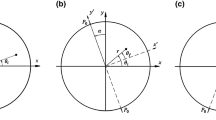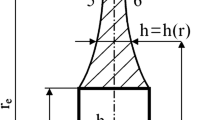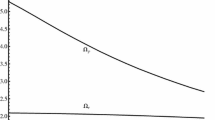Abstract
In this paper, we present a comprehensive investigation of stress propagation in a two-dimensional elastic circular disk. To accurately describe the displacements and stress fields within the disk, we employ a scalar and vector potential approach, representing them as sums of Bessel functions. The determination of the coefficients for these expansions is accomplished in the Laplace space, where we compare the boundary conditions. By converting the inverse Laplace transforms into complex integrals using residue calculus, we successfully derive explicit expressions for the displacements and stress fields. Notably, these expressions encompass primary, secondary, and surface waves, providing a thorough characterization of the stress propagation phenomena within the disk. Our findings contribute to the understanding of mechanical behavior in disk-shaped components and can be valuable in the design and optimization of such structures across various engineering disciplines.









Similar content being viewed by others
References
Timoshenko, S.P., Goodier, J.N.: Theory of Elasticity, 3rd edn. McGraw-Hill, New York (1970)
Fung, Y.C., Tong, P.: Classical and Computational Solid Mechanics, vol. 1. World Scientific, Singapore (2001)
Aki, K., Richards, P.G.: Quantitative Seismology. University Science Books, Sausalito (2002)
Guerrero-Miguel, D.J., Álvarez-Fernández, M.I., García-Fernández, C.C., González-Nicieza, C., Menéndez-Fernández, C.: Analytical and numerical stress field solutions in the Brazilian test subjected to radial load distributions and their stress effects at the centre of the disk. J. Eng. Math. 116, 29 (2019)
Ramesh, K., Sasikumar, S.: Digital photoelasticity: recent developments and diverse applications. Opt. Lasers Eng. 135, 106186 (2020)
Ramesh, K., Shins, K.: Stress field equations for a disk subjected to self-equilibrated arbitrary loads: revisited. Granul. Matter 24(2), 49 (2022)
Shins, K., Ramesh, K.: Closed-form displacement field equations for a disc subjected to self-equilibrated arbitrary loads. Granul. Matter 25(2), 38 (2023)
Hung, K.M., Ma, C.C.: Technical note: theoretical analysis and digital photoelastic measurement of circular disks subjected to partially distributed compressions. Exp. Mech. 43, 216 (2003)
Schönert, K.: Breakage of spheres and circular discs. Powder Technol. 143, 2 (2004)
Ma, C.C., Hung, K.M.: Exact full-field analysis of strain and displacement for circular disks subjected to partially distributed compressions. Int. J. Mech. Sci. 50(2), 275 (2008)
Hua, T., Van Gorder, R.A.: Wave propagation and pattern formation in two-dimensional hexagonally-packed granular crystals under various configurations. Granul. Matter 21(1), 3 (2019)
Landau, L.D., Lifšic, E.M., Lifshitz, E.M., Kosevich, A.M., Pitaevskii, L.P.: Theory of Elasticity, vol. 7. Elsevier, Amsterdam (1986)
Frocht, M.M.: Photoelasticity, vol. 2. Wiley, New York (1941)
Coker, E.G., Filon, L.N.G.: A Treatise on Photo-Elasticity, 2nd edn. Cambridge University Press, Cambridge (1957)
Wang, S., Sloan, S., Tang, C.: Three-dimensional numerical investigations of the failure mechanism of a rock disc with a central or eccentric hole. Rock Mech. Rock Eng. 47, 2117 (2014)
Jiang, Y., Alonso-Marroquín, F., Herrmann, H.J., Mora, P.: Particle fragmentation based on strain energy field. Granul. Matter 22, 1 (2020)
Wu, S., Chau, K.T.: Dynamic response of an elastic sphere under diametral impacts. Mech. Mater. 38(11), 1039 (2006)
Jingu, T., Hisada, K., Nakahara, I., Machida, S.: Transient stress in a circular disk under diametrical impact loads. Bull. JSME 28(235), 13 (1985)
Jingu, T., Nezu, K.: Transient stress in an elastic sphere under diametrical concentrated impact loads. Bull. JSME 28(245), 2553 (1985)
Kessler, D., Kosloff, D.: Elastic wave propagation using cylindrical coordinates. Geophysics 56(12), 2080 (1991)
Hua, W., Xu, J., Dong, S., Song, J., Wang, Q.: Effect of confining pressure on stress intensity factors for cracked Brazilian disk. Int. J. Appl. Mech. 7(03), 1550051 (2015)
Mazel, V., Guerard, S., Croquelois, B., Kopp, J.B., Girardot, J., Diarra, H., Busignies, V., Tchoreloff, P.: Reevaluation of the diametral compression test for tablets using the flattened disc geometry. Int. J. Pharm. 513(1–2), 669 (2016)
Liu, Q., Xin, X., Ma, J., Wang, Y.: Simulating quasi-static crack propagation by coupled peridynamics least square minimization with finite element method. Eng. Fract. Mech. 252, 107862 (2021)
Yu, Y., Yin, J., Zhong, Z.: Shape effects in the Brazilian tensile strength test and a 3D FEM correction. Int. J. Rock Mech. Min. Sci. 43(4), 623 (2006)
Kourkoulis, S., Markides, C.F., Chatzistergos, P.: The Brazilian disc under parabolically varying load: theoretical and experimental study of the displacement field. Int. J. Solids Struct. 49(7–8), 959 (2012)
Zhang, H., Nath, F., Parrikar, P.N., Mokhtari, M.: Analyzing the validity of Brazilian testing using digital image correlation and numerical simulation techniques. Energies 13(6), 1441 (2020)
Abramowitz, M., Stegun, I.A.: Graphs, and Mathematical Tables. Dover Publications, New York (1965)
Press, W.H., Teukolsky, S.A., Vetterling, W.T., Flannery, B.P.: Numerical Recipes 3rd Edition: The Art of Scientific Computing Cambridge University Press, Cambridge (2007)
Goodman, R.E.: Introduction to Rock Mechanics. Wiley, New York (1991)
Vutukuri, V.S., Lama, R.D., Saluja, S.S.: Handbook on Mechanical Properties of Rocks: Testing Techniques and Results. Trans Tech Publications, Clausthal (1974)
See also the supplemental movie. The time evolution of the dimensionless principal stress difference is visualized
Acknowledgements
The authors thank Hisao Hayakawa, Takashi Matsushima, Michio Otsuki, and Kenji Kurosaki for their helpful comments. Numerical computation in this work was partially carried out at the Yukawa Institute Computer Facility.
Funding
This research was partially supported by the Grant-in-Aid of MEXT for Scientific Research (Grant No. JP20K14428 and No. JP21H01006).
Author information
Authors and Affiliations
Contributions
Y.S. and S.T. wrote the main manuscript text. H.I. started the preliminary analysis and Y.S. got the final results. Y.S. mainly prepared all figures. All authors reviewed the manuscript.
Corresponding author
Ethics declarations
Competing interests
The authors declare no competing interests.
Additional information
Publisher’s Note
Springer Nature remains neutral with regard to jurisdictional claims in published maps and institutional affiliations.
Appendices
Appendix A: Derivation of Eq. (22a)–(22e)
In this Appendix, let us give the detailed derivations of the expressions of the static values (22a)–(22e). Because we are only interested in the static values, we omit \(\lim _{t\to \infty}\) in Eq. (20a)–(20e) in this Appendix. Now, we focus on \(\widetilde{\sigma}_{rr}^{(m)}\). To calculate the summation \(\sum _{m=2,4,\ldots}\widetilde{\sigma}_{rr}^{(m)}\cos (m\theta )\), it is convenient to use the following identity:
where \(\Re \) represents the real part, and we have introduced \(r_{1}\), \(r_{2}\), \(\theta _{1}\), and \(\theta _{2}\) as shown in Fig. 1 in the second line of Eq. (38). From this identity, the following is also obtained:
Using Eqs. (38) and (39), one gets
Now, from the definition of \(r^{*1}\), \(r^{*2}\), \(\theta _{1}\), and \(\theta _{2}\) in Eqs. (23a)–(23b), we can easily obtain
From Eqs. (40) and (42) with Eq. (21a), we can reach Eq. (22c). After the similar calculations, we can also derive Eqs. (22a)–(22e).
Appendix B: Stress Components in the Cartesian Coordinates
In this Appendix, we present the expressions of the stress components in the Cartesian coordinates. Once we obtain the expressions in the polar coordinates, it is straightforward to obtain those in the Cartesian coordinates as [1]
Substituting Eqs. (22a)–(22e) into Eqs. (43a)–(43c), we can obtain
respectively [1]. This shows that \(\widetilde{\sigma}_{yy}\) becomes constant (\(\widetilde{\sigma}_{yy}=1\)) along the line parallel to the loading (\(\theta _{1}=\theta _{2}=0\)).
Appendix C: Derivation of the Speed of the Rayleigh Wave
In this Appendix, we derive the speed of the Rayleigh wave. The Rayleigh waves are produced by P- and S-waves, and propagate over the surface of the disk. Let \(c\) be the speed of the Rayleigh wave. Now, it is convenient to have the origin on the surface of the disc, that is,
and use the coordinate system \((r^{\prime}, \theta )\). Then, we assume that both the scalar and vector potentials are described by
respectively. Substituting Eq. (46a) into the wave equation, the amplitude \(\mathcal{A}_{\mathrm{L}}\) should satisfy
We should choose a solution, which does not diverge for \(r\ll 0\). After this choice, the scalar potential is written as
Similarly, the vector potential is given by
where \(C_{1}\) and \(C_{2}\) are constants. If the second terms in the root of Eqs. (46a) and (49) is much smaller than unity, we can rewrite them as
This solution needs to satisfy the boundary condition (1a)–(1b). After some calculations, the quantity \(X\equiv c^{2}/c_{\mathrm{T}}^{2}\) should satisfy the following equation:
This is nothing but Eq. (35) in the main text.
Rights and permissions
Springer Nature or its licensor (e.g. a society or other partner) holds exclusive rights to this article under a publishing agreement with the author(s) or other rightsholder(s); author self-archiving of the accepted manuscript version of this article is solely governed by the terms of such publishing agreement and applicable law.
About this article
Cite this article
Sato, Y., Ishikawa, H. & Takada, S. Revisiting Stress Propagation in a Two-Dimensional Elastic Circular Disk Under Diametric Loading. J Elast (2024). https://doi.org/10.1007/s10659-023-10047-4
Received:
Accepted:
Published:
DOI: https://doi.org/10.1007/s10659-023-10047-4




